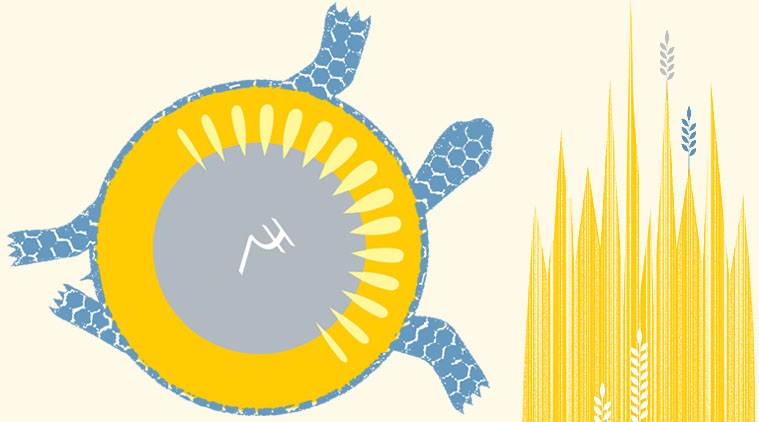
With elections approaching, every party is swearing by farmers and trying to woo them for their votes. The Narendra Modi government has already announced a package of Rs 75,000 crore for about 12.6 crore small and marginal farmers. While in absolute terms, this looks sizeable, once it is divided by the number of farm families to be covered, the amount is very small — just Rs 6,000 per family per year, which is about 6 per cent of their annual income. This level of support, unless augmented further, may not go far in winning the farmers’ confidence. Most would agree that farmers have been under stress for quite some time, and have not got justice so far.
While the Modi government claims that its record on overall growth (GDP) is better than the UPA government’s (notwithstanding the suspicions many have about the revised GDP series), it is the nature of growth that matters as well. In a country where 47 per cent of the workforce is engaged in agriculture, it is the growth of agri-GDP that is even more critical for the alleviation of poverty and providing nutritious food.
The average annual agri-GDP growth in the first four years of the Modi government, for which data is available, is just 2.5 per cent compared to 5.2 per cent in the last four years of the UPA government. The exports of agri-produce have fallen since the peak of $42.5 billion, achieved in 2013-14, to a negative growth in agri-exports during the Modi government’s tenure. On the other hand, agri-imports have consistently risen, reducing the net export surplus (exports minus imports) from about $25 billion in 2013-14 to less than $10 billion in 2017-18. This has led to a glut of agri-produce at home and, consequently, prices have fallen, reducing the profitability ratio across most crops significantly, since 2013-14. And so also is the case with dairy. The government is saddled with massive stocks of grains, far above the buffer stock norms. For example, rice stocks with government agencies touched about 37 MMT on January 1, as against a buffer norm of only 7.6 MMT for that date. This speaks of massive inefficiency in the grain management system.
Needless to say, agriculture has been crying for wholesale structural reforms, especially in agri-marketing, from abolition/pruning of the Essential Commodities Act to reforming APMC, to futures trading, to a negotiable warehouse receipt system, to building commodity-specific value chains on the lines of Amul’s milk model, etc. But the time for structural reforms has run out. And now, there is a race to compensate farmers for their losses, an admission of the failure of the agriculture policy followed so far, which has a massive in-built consumer bias.
India wants to compete with China and become a force in the world. It cannot do so unless it supports its farmers in a systematic manner. The Producer Support Estimates (PSEs) of India, China and the OECD clearly show that India has been implicitly taxing its farmers through restrictive trade and marketing policies. On the contrary, China supported its farmers to the tune of $232 billion and the OECD countries by $235 billion in 2016-17 alone (see graph). No wonder China produces more than triple of India’s agri-output from a lesser cropped area.
Congress President Rahul Gandhi is going around the country and promising loan waivers to farmers, promising even higher MSPs (in Chhattisgarh, the Congress government has raised the MSP for paddy from Rs 1,750/quintal to Rs 2,500/quintal), and now a minimum monthly income for the poor. He has not spelt out yet what would be its size, and who all would be covered under it. Loan waivers and higher MSPs have serious limitations in terms of their reach. They cannot reach more than 30 per cent of the farmers. Direct income support has much better reach but will also cost more. My guess is that the package could be anywhere between Rs 2 lakh crore to Rs 3 lakh crore, almost three to four times higher than the package announced by the Modi government. And this can swing farmers’ votes.
If the fisc has to be kept within reasonable bounds, money has to be found by rationalising some other programmes. My two-penny unsolicited advice to all political parties is that it is time to revisit the food subsidy and MGNREGA programmes and rationalise them. Food subsidy for consumers is Rs 1,84,220 crore and the MGNREGA is budgeted at Rs 60,000 crore in the current Union budget. On top of this, there are the pending bills of the Food Corporation of India, which amounted to about Rs 1.35 lakh crore in April 2018, and may not be much less in April 2019. So, in a way, for the so-called “poor”, the safety nets cost anywhere between Rs 3.5 to 4 lakh crore.
The problem is that food subsidy covers 67 per cent of the population, with massive leakages. This needs restructuring and rationalisation. For example, if one restricts food subsidy to the bottom 20-25 per cent of the population, and links issue price to at least half the economic cost of the FCI, gives cash in lieu of grains to farmers, and restricts MGNREGA to drought years and/or merges it with agri-operations, one can easily save more than Rs 1 lakh crore per annum. This can be diverted to farmers. Similarly, put the fertiliser subsidy directly into the accounts of farmers, and let them choose whether they want to do organic farming or use chemicals. DBT through cash in farmers’ account with linkage to Aadhaar, their bank accounts, geo-tagging of farms, and updating of land records is a better way to support farmers than loan waivers and unduly high MSPs. It may be noted that this is not a substitute to either the structural reforms or investments that are needed in agriculture. In fact, this is a sort of atonement for not acting on those fronts.
(Gulati is an Infosys Chair professor for Agriculture at ICRIER)